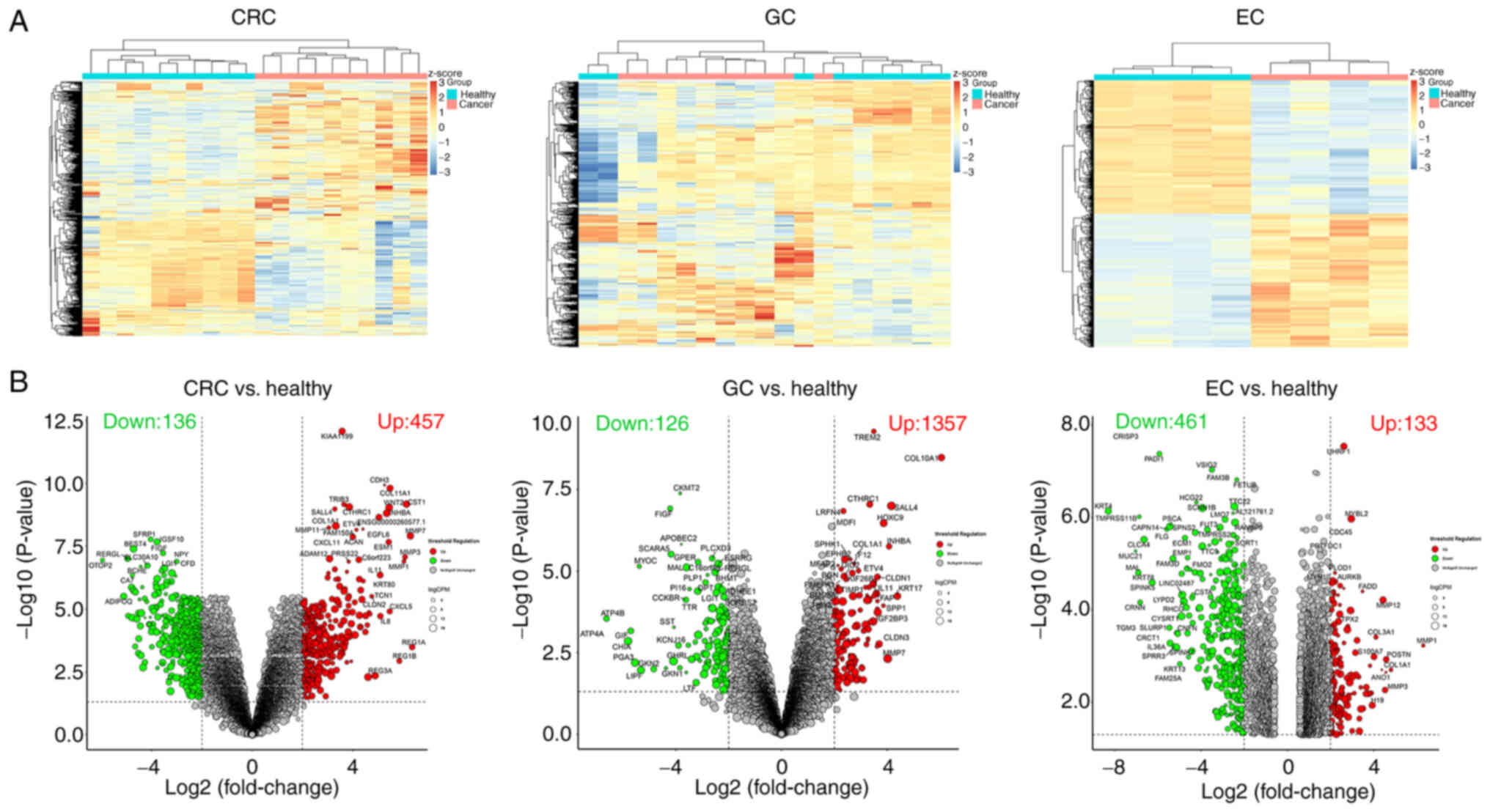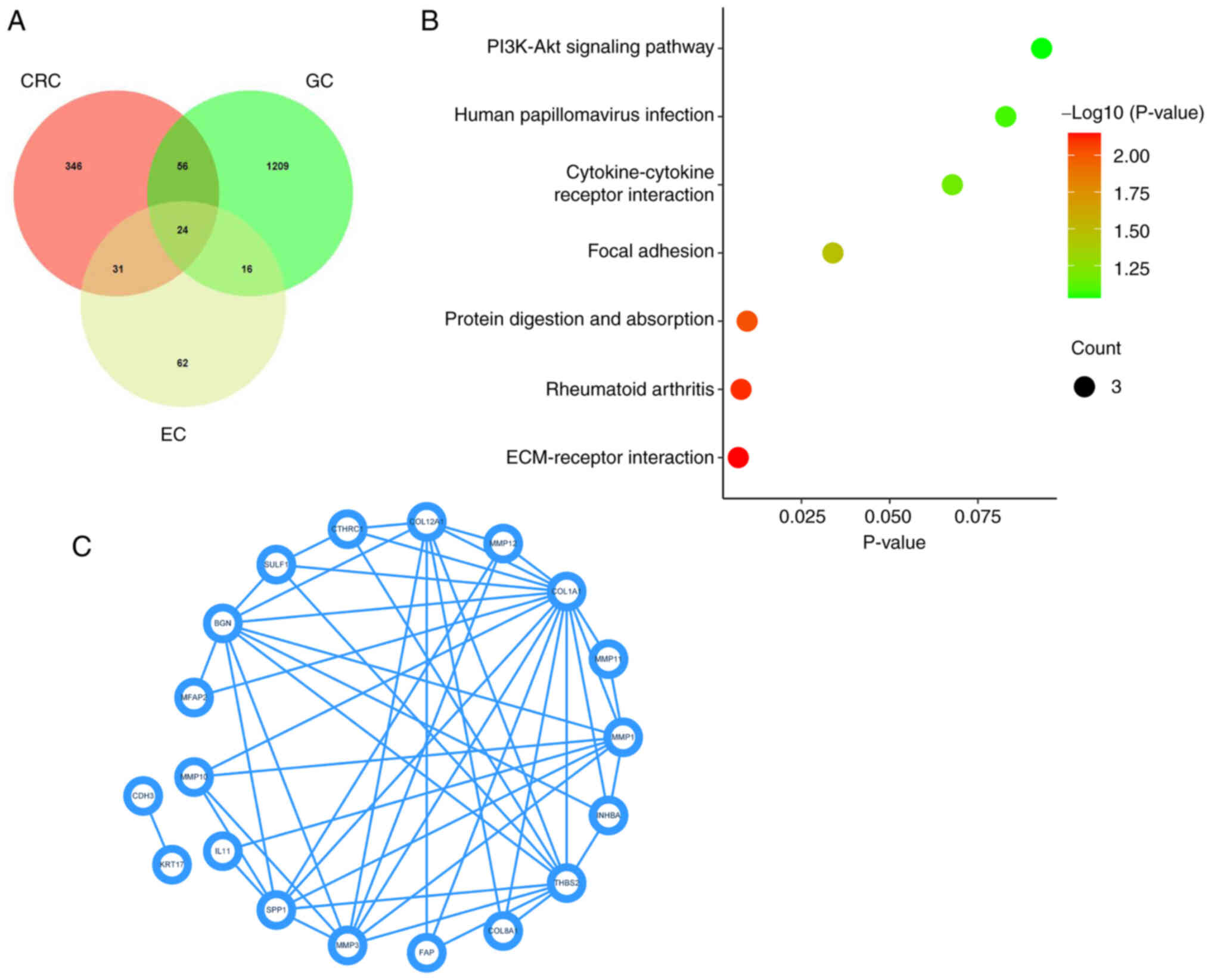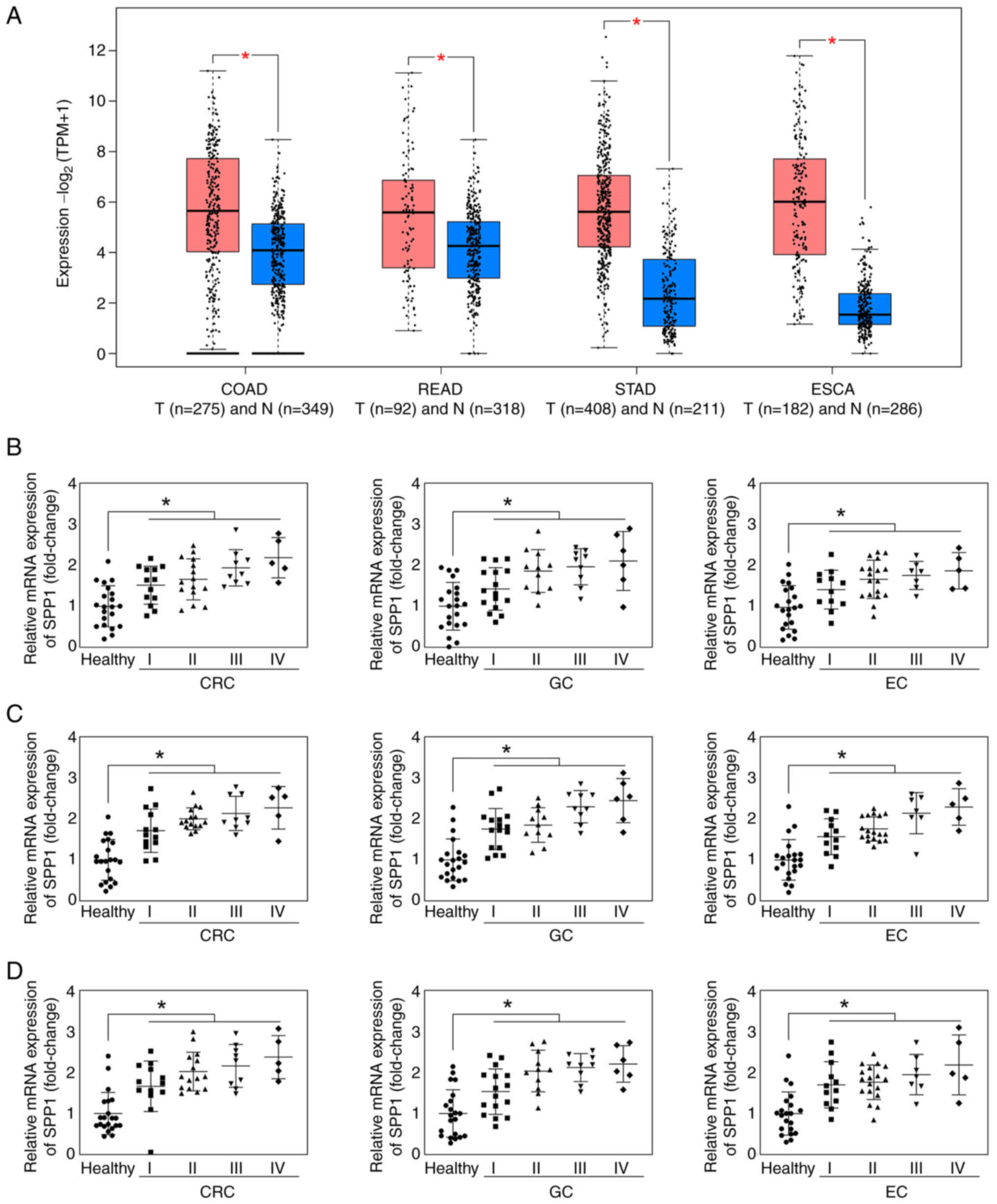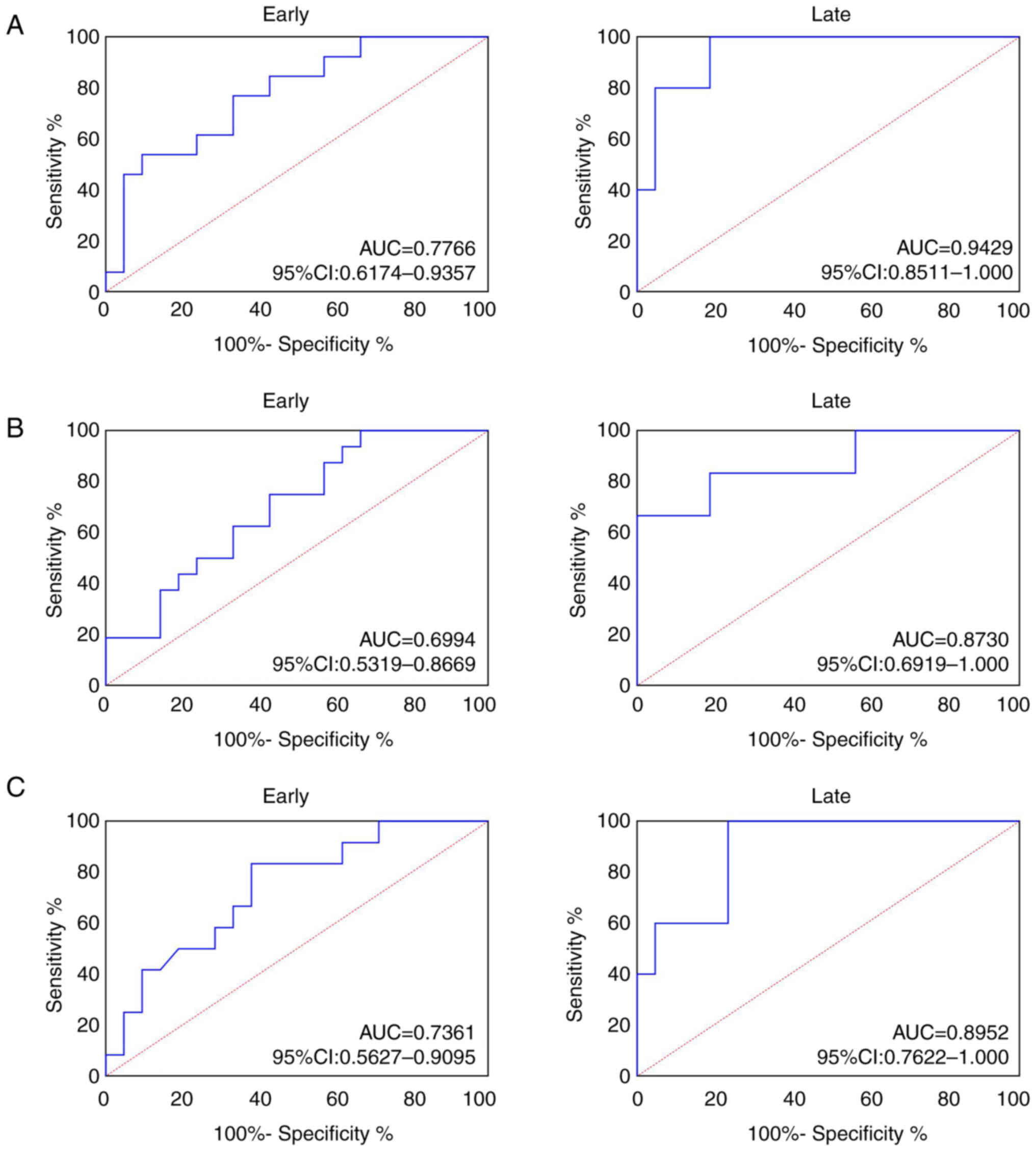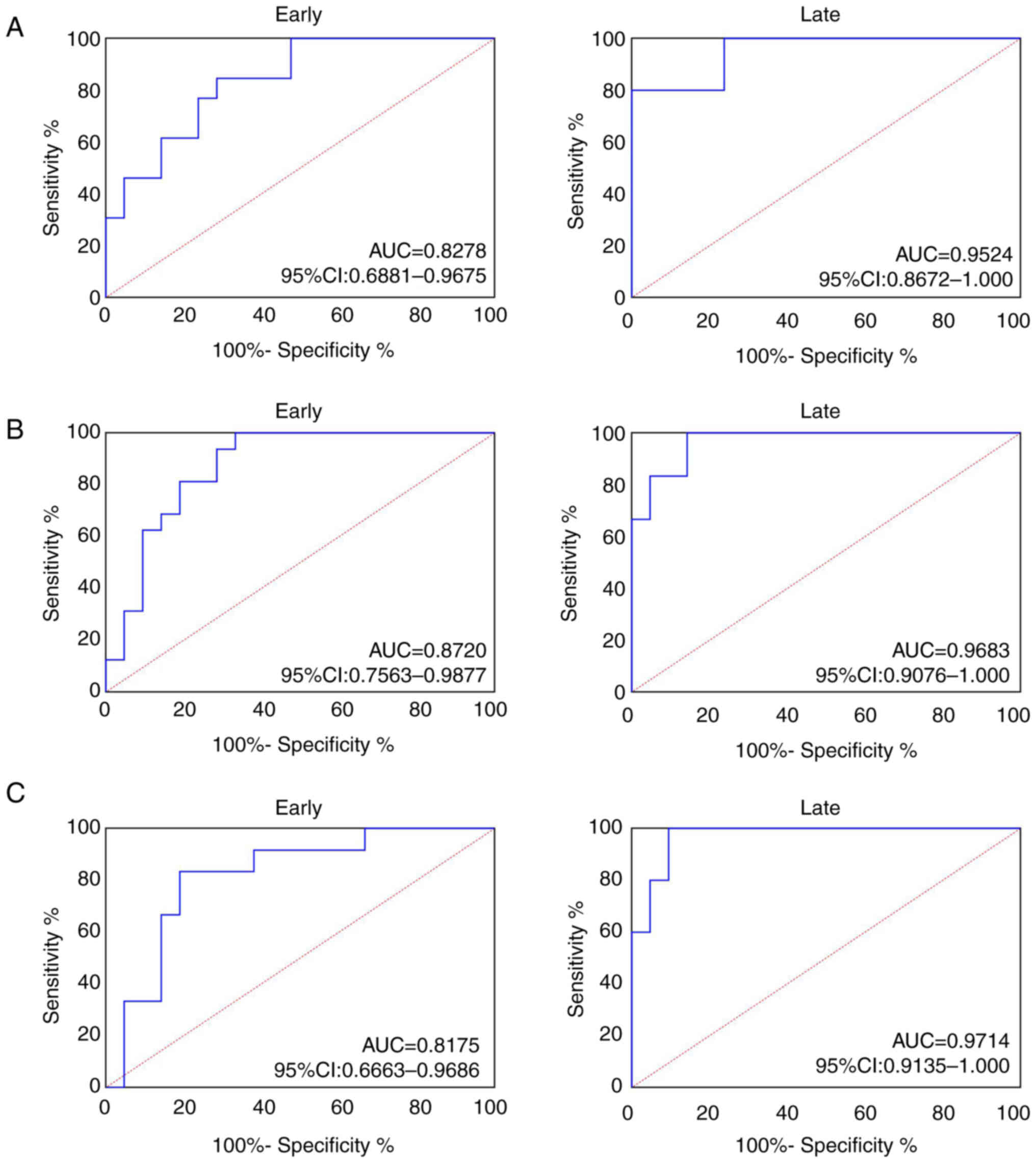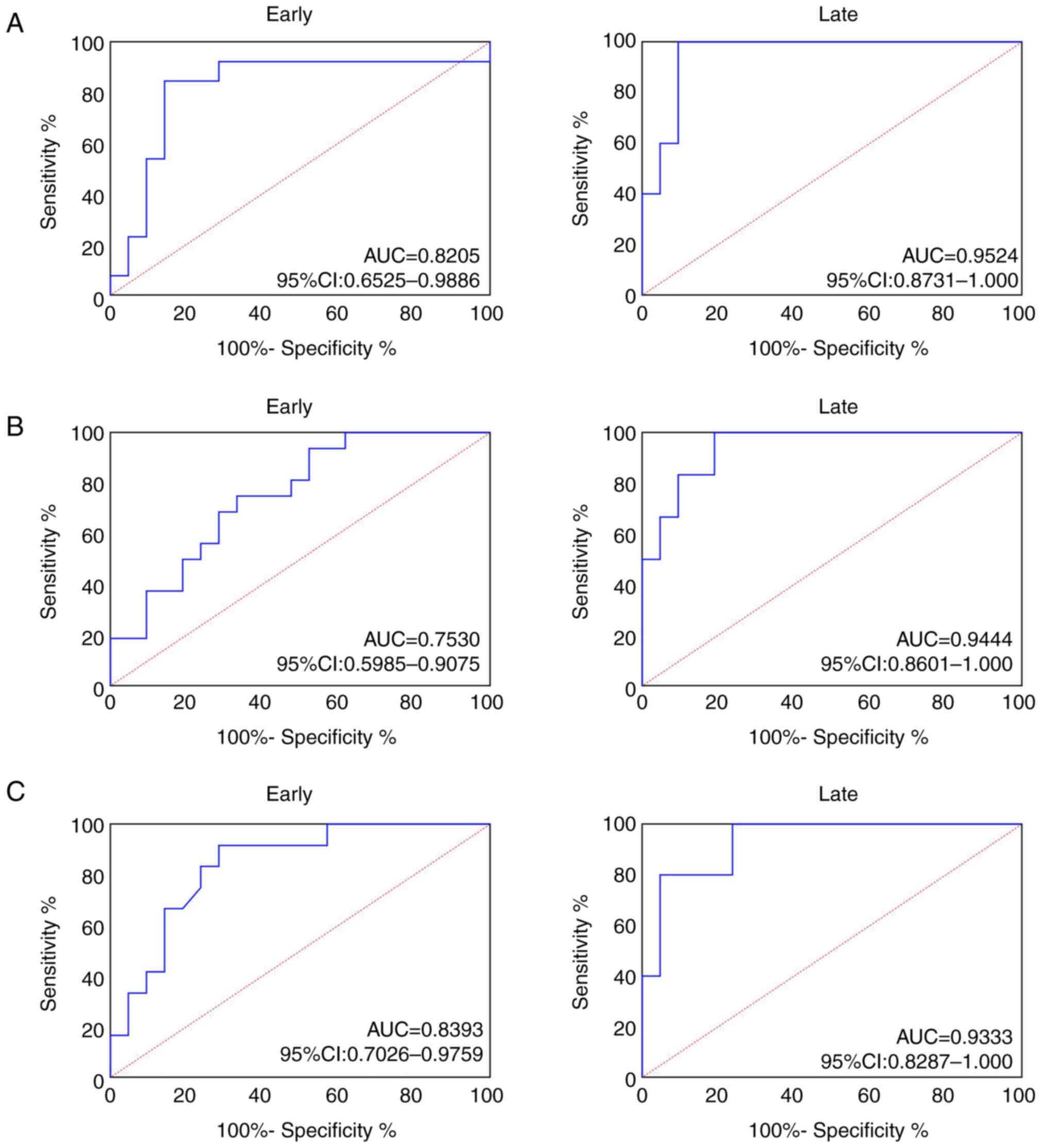Role of SPP1 in the diagnosis of gastrointestinal cancer
- Authors:
- Published online on: August 7, 2023 https://doi.org/10.3892/ol.2023.13997
- Article Number: 411
Abstract
Introduction
In recent years, the incidence rate of digestive system tumors has increased in China, which accounts for 38.71% of the total new cases of tumors. In addition, around the world, digestive system tumors account for 23.48% of new cases of tumors. These tumors have recently occurred in a younger population (aged <49 years) (1,2). The global cancer statistics report, containing cancer estimates from GLOBOCAN 2020 and population estimates from the United Nations, demonstrated that the incidence rate of cancer in China is lower than that in other countries; however, the fatality rate is higher (3). Of note, 45.03% of cancer-associated deaths are due to gastrointestinal tumors and the prognosis is relatively poor in China, which is higher than the global mortality rate (30.91%) (4). This may be due to lack of early diagnosis and inconsistent clinical treatment strategies in different regions of China. Its treatment strategies mainly include surgery, radiation therapy, chemotherapy and endoscopic treatment (5). Digestive system tumors exhibit no notable adverse symptoms in the early stages, making early diagnosis difficult. Thus, the majority of these tumors are diagnosed at intermediate or late stages, at which point symptoms, such as sudden weight loss, alternating occurrence of constipation and diarrhea and haematemesis, are aggravated with increased risk of metastasis and recurrence (6). Therefore, earlier diagnosis of digestive system tumors is required. Compared with gastroscopy, enteroscopy, barium meal imaging and other examination techniques, detection of serum tumor markers (alpha-fetoprotein, carcinoembryonic antigen, etc.) using a serum biochemical analyzer exhibits numerous advantages. Detection of serum tumor markers is simple, fast, non-invasive and accurate (1). Serum tumor markers may be used to assess occurrence, progression and treatment of tumors and they may exhibit different levels of specificity in different tumors. Serum tumor markers may detect and differentiate between different types of gastrointestinal cancer and improve the positive detection rate of tumors (7–9). Therefore, further investigation into effective early diagnostic markers is required for the treatment of digestive system tumors.
Secreted phosphoprotein 1 (SPP1), also known as osteopontin, is an integrin-binding protein secreted by various types of cell, such as macrophages, endothelial cells and osteoclasts (10). In humans, SPP1 consists of six introns and seven exons, and it is encoded on chromosome 4q13 (11). SPP1 involves multiple physiological and pathological processes, such as tumor growth, adhesion and invasion (12–15). Of note, SPP1 expression is increased in lung (12), colon (13), breast (14), prostate (15) and pancreatic cancer (16) and hepatocellular carcinoma (17). The expression levels of SPP1 are associated with the stage and degree of malignancy of tumors, highlighting that SPP1 may serve as a biomarker for the diagnosis and prognosis of numerous cancers. However, the potential of SPP1 as a marker of digestive system tumors is yet to be fully elucidated.
Thus, the present study aimed to further explore the expression and potential clinical values of SPP1 in the plasma, serum and tissues of patients with colorectal cancer (CRC), gastric cancer (GC) and esophageal cancer (EC).
Patients and methods
Bioinformatics analysis
The microarray datasets GSE104836 (18), GSE189830 (19) and GSE103236 (20) were downloaded from the Gene Expression Omnibus (GEO) database (https://www.ncbi.nlm.nih.gov/geo/). The online tool GEO2R (version 2.40.0; http://www.ncbi.nlm.nih.gov/geo/geo2r/) was used to analyze differentially expressed genes (DEGs) in patients with CRC, GC or EC based on an adjusted P-value<0.01 and |log2 fold change|>2. DEGs were displayed as a heatmap and volcano map using R software (version 3.6.1; MathSoft). Kyoto Encyclopedia of Genes and Genomes (KEGG) pathway enrichment analysis was performed using KOBAS (version 3.0; kobas.cbi.pku.edu.cn/). The Gene Expression Profiling Interactive Analysis (GEPIA) online database (http://gepia.cancer-pku.cn/) was used to analyzed the expressions of SPP1 in colon, rectum and stomach adenocarcinoma and EC patients. STRING online database (https://string-db.org/) was used to analyze the protein-protein-interaction (PPI) networks of upregulated genes in CRC, GC and EC.
Clinical resources
A total of 42 patients with pathologically confirmed CRC, GC or EC who were admitted to Hubei No. 3 People's Hospital of Jianghan University (Wuhan, China) were recruited between January 2022 and January 2023. CRC and GC were confirmed to be adenocarcinoma and EC was confirmed to be squamous cell carcinoma. The clinicopathological characteristics of the patients are presented in Table I. A total of 21 healthy volunteers were included as the control group from January 2022 to January 2023 for CRC, GC or EC, respectively. Tumor tissue was collected from patients in the tumor groups and serum and plasma samples were collected from both the control and tumor groups. Supernatant was collected following low-speed centrifugation (1,370 × g, 5 min) at 4°C and all samples were stored at −80°C for future use. The present study was approved by the Ethics Committee of Hubei No. 3 People's Hospital of Jianghan University (Wuhan, China; approval no. 013). Written informed consent was obtained from all participants prior to inclusion in the study.
Table I.Clinicopathological characteristics of healthy volunteers (n=21) and patients with CRC (n=42), GC (n=42) or EC (n=42). |
Inclusion criteria were as follows: i) Malignant tumor located in the digestive tract of patients in the tumor group confirmed via pathological examination; ii) no digestive tract disease diagnosed in patients in the control group and iii) all patients volunteered to participate.
Exclusion criteria were as follows: i) Patients with tumors located in other parts of the body or gastrointestinal cancer patients with metastasis to other parts of the body; ii) patients with serious acute or chronic infections or autoimmune disease; iii) patients who use antibiotics, proton pump inhibitors, anticoagulants or other drugs that may affect the examination results and iv) patients who received radiotherapy and chemotherapy in the past 6 months.
Reverse transcription-quantitative PCR (RT-qPCR)
RT-qPCR was used to determine mRNA expression levels of SPP1 and carcinoembryonic antigen (CEA). Total RNA was isolated from tissues and serum of control subjects and cancer patients using TRIzol® reagent (Beyotime Institute of Biotechnology) and cDNA was synthesized using a RT kit (Takara Bio, Inc.). Reaction conditions were as follows: 37°C for 15 min, 85°C for 5 sec. qPCR was performed using a Power SYBR™ Green RNA-to-CT™ 1-Step kit (Takara Bio, Inc.). Reaction conditions were as follows: 94°C for 30 sec, 45 cycles of (95°C for 5 sec, 60°C for 30 sec, 72°C for 30 sec). Expression levels were normalized to GAPDH and calculated using the 2−ΔΔCq method (21). The primer sequences (5′-3′) were as follows: SPP1 forward, CTCCATTGACTCGAACGACTC and reverse, CAGGTCTGCGAAACTTCTTAGAT; CEA forward, ATTCAAGCAAATATCCCAGGGG and reverse, GGCATTTATGGTTCGTAGGGTG; GAPDH forward TGTGGGCATCAATGGATTTGG and reverse, ACACCATGTATTCCGGGTCAAT.
Statistical analysis
Results were analyzed using SPSS software (version 22.0; IBM Corp.) and GraphPad Prism (version 5.01; Dotmatics). Data are presented as the mean ± standard deviation. All experiments were independently repeated three times. Differences between two groups were analyzed using an unpaired Student's t-test. Differences between >2 groups were assessed by one-way ANOVA followed by Tukey's post-hoc test. Clinicopathological characteristics were compared by χ2 test. Moreover, correlation was determined using Pearson's correlation coefficient. Receiver operating curve (ROC) was used to analyze clinical significance of SPP1 with area under the curve (AUC) as the evaluation index. Z-score in R software: (expressions levels-average value)/standard deviation. P<0.05 was considered to indicate a statistically significant difference.
Results
DEGs determined in CRC, GC and EC
Using GSE104836, GSE189830 and GSE103236 datasets, a total of 24 DEGs were determined in patients with CRC, GC or EC. DEGs in CRC, GC and EC were displayed as a heat map (Fig. 1A) and volcano plot (Fig. 1B). Upregulated genes in CRC (n=346), GC (n=1209) and EC (n=62) were selected through the GSE104836, GSE189830 and GSE103236 datasets and displayed using a Venn diagram. A total of 24 genes were highly expressed in CRC, GC and EC (Fig. 2A). KEGG pathway enrichment analysis demonstrated that 24 genes were enriched in ‘ECM-receptor interaction’, ‘rheumatoid arthritis’, ‘protein digestion and absorption’, ‘focal adhesion’, ‘cytokine-cytokine receptor interaction’, ‘human papillomavirus infection’ and ‘PI3K-Akt signaling pathway’ (Fig. 2B). The Protein-protein interaction of 24 DEGs is displayed in Fig. 2C. SPP1 was enriched in ‘ECM-receptor interaction’, ‘focal adhesion’, ‘cytokine-cytokine receptor interaction’ and the ‘PI3K-Akt signaling pathway’. All these pathways were closely related to the cancer development. Hence, SPP1 was selected for use in subsequent experiments.
SPP1 is upregulated in patients with CRC, GC or EC
Subsequently, patients and healthy controls were recruited for the next experiments. The clinicopathological characteristics, including age, sex, smoking status, alcohol consumption status, tumor differentiation and American Joint Committee on Cancer stage (22) were recorded. In the CRC group, 31 patients were aged >65 years (mean age, 68.00 years); in the GC group, 28 patients were aged >65 years (mean age, 66.40 years); and in the EC group, 27 were aged >65 years (mean age, 65.57 years). In addition, there were 26 males and 16 females in the CRC group, 29 males and 13 females in the GC group, and 25 males and 17 females in the EC group. Generally speaking, patients with gastrointestinal cancer were older and had a higher proportion of males. In addition, there was no significant difference in sex and age between the healthy group and the cancer group (Table I). Using the GEPIA online database, the present study demonstrated that SPP1 was significantly upregulated in colon, rectum and stomach adenocarcinoma and EC (Fig. 3A). In addition, SPP1 expression levels were determined in patients with CRC, GC and EC. SPP1 was significantly upregulated in the plasma (Fig. 3B), serum (Fig. 3C) and tissue (Fig. 3D) of patients with CRC, GC and EC at stages I, II, III and IV.
SPP1 expression levels in plasma of patients with CRC, GC and EC exhibit diagnostic value
ROC analysis was performed to explore the role of SPP1 in patients with CRC, GC and EC. The AUC of plasma SPP1 was 0.7766 (95% confidence interval, 0.6174–0.9351) in early and 0.9429 (95% confidence interval, 0.8511–1.0000; Fig. 4A) in late CRC. AUC of plasma SPP1 in patients with early GC was 0.6994 (95% confidence interval, 0.5319–0.8669) and 0.8730 (95% confidence interval, 0.6919–1.000; Fig. 4B) in patients with late GC. AUC of plasma SPP1 in patients with early EC was 0.7361 (95% confidence interval, 0.5627–0.9095) and 0.8952 (95% confidence interval, 0.7622–1.000; Fig. 4C) in patients with late EC. These results revealed that SPP1 exhibited notable diagnostic significance for CRC, GC and EC.
SPP1 expression levels in serum of patients with CRC, GC and EC exhibit diagnostic value
AUC of serum SPP1 in patients with early CRC was 0.8278 (95% confidence interval, 0.6881–0.9675) and 0.9524 (95% confidence interval, 0.8672–1.000; Fig. 5A) in patients with late CRC. AUC of serum SPP1 in patients with early GC was 0.8720 (95% confidence interval, 0.7563–0.9877) and 0.9683 (95% confidence interval, 0.9076–1.000; Fig. 5B) in patients with late GC. AUC of serum SPP1 in patients with early EC was 0.8175 (95% confidence interval, 0.6663–0.9686) and 0.9714 (95% confidence interval, 0.9135–1.0000; Fig. 5C) in patients with late EC.
SPP1 expression levels in cancer tissue of patients with CRC, GC and EC exhibit diagnostic value
AUC of tissue SPP1 was 0.8205 in patients with early CRC (95% confidence interval, 0.6525–0.9886) and 0.9524 (95% confidence interval, 0.8731–1.000; Fig. 6A) in patients with late CRC. AUC of tissue SPP1 in patients with early GC was 0.7530 (95% confidence interval, 0.5985–0.9075) and 0.9444 (95% confidence interval, 0.8601–1.000; Fig. 6B) in patients with late GC. AUC of tissue SPP1 in patients with early EC was 0.8393 (95% confidence interval, 0.7026–0.9759) and 0.9333 (95% confidence interval, 0.8287–1.000; Fig. 6C) in patients with late EC.
SPP1 and CEA are positively correlated in patients with CRC, GC and EC
Pearson's correlation coefficient revealed that SPP1 and CEA were positively correlated in the serum of patients with CRC (r=0.7201; Fig. 7A), GC (r=0.5065; Fig. 7B) and EC (r=0.6119; Fig. 7C). These results indicated that SPP1 may be a potential diagnostic marker for CRC, GC and EC.
Discussion
Malignant tumors pose a serious threat to human health and tumors with no specific symptoms in early or intermediate stages of disease may metastasize, leading to missed diagnosis (23,24). Patients with digestive tract malignant tumors may also exhibit dysphagia, abdominal pain, gastrointestinal discomfort and other symptoms, and the clinical manifestations differ between different types of digestive tract malignant tumor. Therefore, early diagnosis of digestive tract malignant tumors and early symptomatic treatment may improve prognosis and 5-year survival rate (25,26). The present study demonstrated that SPP1 expression was upregulated in patients with CRC, GC and EC. ROC analysis revealed that SPP1 exhibited notable diagnostic significance for CRC, GC and EC, which highlighted the potential of SPP1 as a molecular biomarker.
To the best of our knowledge, research into the specific mechanisms and roles of SPP1 in cancer development and metastasis is lacking. Thus, the present study aimed to analyze the prognostic and diagnostic value and expression levels of SPP1 in CRC, GC and EC. To the best of our knowledge, the specific role of SPP1 as a tumor promoter or suppressor is yet to be fully elucidated and this cannot be determined using only expression levels. However, extensive carcinogenic databases may provide understanding of the molecular mechanisms underlying SPP1. Results of previous studies demonstrated that SPP1 is upregulated in breast, prostate, colon, head and neck, liver, lung and esophageal cancer (12,27–30). Notably, high SPP1 expression levels are associated with poor prognosis of the aforementioned cancers. Previous studies demonstrated that SPP1 may enhance survival, angiogenesis and inflammatory response of cancer cells and promote epithelial-to-mesenchymal transition (31–33). The aforementioned studies indicated that SPP1 may promote tumor progression. Therefore, further investigations into the role of SPP1 in digestive tract malignant tumors are required.
KEGG pathway enrichment analysis indicated that SPP1 was enriched in ‘tumor development-related pathway’. Subsequently, through detecting SPP1 expression levels in cancer tissue, serum and plasma of patients with CRC, GC and EC, the present study revealed that SPP1 was significantly upregulated in different stages of disease. In stages III and IV, the upregulation of SPP1 was more significant than in stages I and II. In addition, ROC analysis demonstrated that SPP1 expression levels in cancer tissue, serum and plasma were of diagnostic value for early and advanced CRC, GC and EC, which was indicated by a high AUC for SPP1 in cancer tissue, serum and plasma. However, the present study had certain limitations. For instance, only the expression levels of SPP1 were detected in patients with CRC, GC and EC, and the sample size was small. Further in vitro and in vivo experiments are required to determine the specific mechanisms of SPP1 in digestive tract malignant tumors.
In conclusion, the present study demonstrated that SPP1 expression was upregulated in CRC, GC and EC. Thus, SPP1 may exhibit potential as a novel serological marker for the auxiliary diagnosis of digestive tract malignant tumors. SPP1 expression may also exhibit potential in early diagnosis of digestive tract malignant tumors and provide a reference for tumor staging and treatment strategies.
Acknowledgements
Not applicable.
Funding
Funding: No funding was received.
Availability of data and materials
The datasets used and/or analyzed during the current study are available from the corresponding author on reasonable request.
Authors' contributions
LJ, SL and NJ made substantial contributions to conception and design of the study and acquisition of data. All authors read and approved the final manuscript. LJ, SL and NJ confirm the authenticity of all the raw data.
Ethics approval and consent to participate
The present study protocol was approved by the Ethics Committee of Hubei No.3 People's Hospital of Jianghan University (Wuhan, China; approval no. 013). Written informed consent was obtained from all participants prior to inclusion in the study.
Patient consent for publication
Not applicable.
Competing interests
The authors declare that they have no competing interests.
References
|
Ma ZY, Gong YF, Zhuang HK, Zhou ZX, Huang SZ, Zou YP, Huang BW, Sun ZH, Zhang CZ, Tang YQ, et al: Pancreatic neuroendocrine tumors: A review of serum biomarkers, staging and management. World J Gastroenterol. 26:2305–2322. 2020. View Article : Google Scholar : PubMed/NCBI | |
|
Zhang Y, Sun J, Song Y, Gao P, Wang X, Chen M, Li Y and Wu Z: Roles of fusion genes in digestive system cancers: Dawn for cancer precision therapy. Crit Rev Oncol Hematol. 171:1036222022. View Article : Google Scholar : PubMed/NCBI | |
|
Xia C, Dong X, Li H, Cao M, Sun D, He S, Yang F, Yan X, Zhang S, Li N and Chen W: Cancer statistics in China and United States, 2022: Profiles, trends, and determinants. Chin Med J (Engl). 135:584–590. 2022. View Article : Google Scholar : PubMed/NCBI | |
|
Feng RM, Zong YN, Cao SM and Xu RH: Current cancer situation in China: good or bad news from the 2018 global cancer statistics? Cancer Commun (Lond). 39:222019. View Article : Google Scholar : PubMed/NCBI | |
|
Wang H, An J, He S, Liao C, Wang J and Tuo B: Chloride intracellular channels as novel biomarkers for digestive system tumors (review). Mol Med Rep. 24:6302021. View Article : Google Scholar : PubMed/NCBI | |
|
Li HS, He T and Yang LL: Adenosquamous carcinoma of the digestive system: A literature review. Scand J Gastroenterol. 55:1268–1276. 2020. View Article : Google Scholar : PubMed/NCBI | |
|
Zhang X, Xia D, Wang RX, Zhang YT, Zhang SY, Yang C, Pan XR and Tong JH: Identification of potential biomarkers for digestive system cancers from serum-derived extracellular vesicle RNA. Clin Chim Acta. 531:36–47. 2022. View Article : Google Scholar : PubMed/NCBI | |
|
Wen R, Lin P, Wu Y, Yin H, Huang W, Guo D, Peng Y, Liu D, He Y and Yang H: Diagnostic value of CEUS LI-RADS and serum tumor markers for combined hepatocellular-cholangiocarcinoma. Eur J Radiol. 154:1104152022. View Article : Google Scholar : PubMed/NCBI | |
|
Zhang Z, Miao L, Wang S, Zhao Y, Xie Y, Yun H, Ren Z, Wang G, Teng M and Li Y: Study on the expression of c-Met in gastric cancer and its correlation with preoperative serum tumor markers and prognosis. World J Surg Oncol. 20:1–204. 2022. | |
|
Wu G, Li X, Seo H, Mclendon BA, Kramer AC, Bazer FW and Johnson GA: Osteopontin (OPN)/secreted phosphoprotein 1 (SPP1) binds integrins to activate transport of ions across the porcine placenta. Front Biosci (Landmark Ed). 27:1172022. View Article : Google Scholar : PubMed/NCBI | |
|
Li S, Yang R, Sun X, Miao S, Lu T, Wang Y, Wo Y and Jiao W: Identification of SPP1 as a promising biomarker to predict clinical outcome of lung adenocarcinoma individuals. Gene. 679:398–404. 2018. View Article : Google Scholar : PubMed/NCBI | |
|
Zhang Y, Du W, Chen Z and Xiang C: Upregulation of PD-L1 by SPP1 mediates macrophage polarization and facilitates immune escape in lung adenocarcinoma. Exp Cell Res. 359:449–457. 2017. View Article : Google Scholar : PubMed/NCBI | |
|
Wei R, Wong J, Lyu P, Xi X, Tong O, Zhang SD, Yuen HF, Shirasawa S and Kwok HF: In vitro and clinical data analysis of Osteopontin as a prognostic indicator in colorectal cancer. J Cell Mol Med. 22:4097–4105. 2018. View Article : Google Scholar : PubMed/NCBI | |
|
Changchien CY, Chang HH, Dai MS, Tsai WC, Tsai HC, Wang CY, Shen MS, Cheng LT, Lee HS, Chen Y, et al: Distinct JNK/VEGFR signaling on angiogenesis of breast cancer-associated pleural fluid based on hormone receptor status. Cancer Sci. 112:781–791. 2021. View Article : Google Scholar : PubMed/NCBI | |
|
Pang X, Xie R, Zhang Z, Liu Q, Wu S and Cui Y: Identification of SPP1 as an extracellular matrix signature for metastatic castration-resistant prostate cancer. Front Oncol. 9:9242019. View Article : Google Scholar : PubMed/NCBI | |
|
Huang L, Holtzinger A, Jagan I, Begora M, Lohse I, Ngai N, Nostro C, Wang R, Muthuswamy LB, Crawford HC, et al: Ductal pancreatic cancer modeling and drug screening using human pluripotent stem cell- and patient-derived tumor organoids. Nat Med. 21:1364–1371. 2015. View Article : Google Scholar : PubMed/NCBI | |
|
Lao L, Shen J, Tian H, Zhong G, Murray SS and Wang JC: Secreted phosphoprotein 24kD (Spp24) inhibits growth of hepatocellular carcinoma in vivo. Environ Toxicol Pharmacol. 51:51–55. 2017. View Article : Google Scholar : PubMed/NCBI | |
|
Leng X, Yang J, Liu T, Zhao C, Cao Z, Li C, Sun J and Zheng S: A bioinformatics framework to identify the biomarkers and potential drugs for the treatment of colorectal cancer. Front Genet. 13:10175392022. View Article : Google Scholar : PubMed/NCBI | |
|
Ren L, Fang X, Shrestha SM, Ji Q, Ye H, Liang Y, Liu Y, Feng Y, Dong J and Shi R: LncRNA SNHG16 promotes development of oesophageal squamous cell carcinoma by interacting with EIF4A3 and modulating RhoU mRNA stability. Cell Mol Biol Lett. 27:892022. View Article : Google Scholar : PubMed/NCBI | |
|
Yang C and Gong A: Integrated bioinformatics analysis for differentially expressed genes and signaling pathways identification in gastric cancer. Int J Med Sci. 18:792–800. 2021. View Article : Google Scholar : PubMed/NCBI | |
|
Livak KJ and Schmittgen TD: Analysis of relative gene expression data using real-time quantitative PCR and the 2(−Delta Delta C(T)) method. Methods. 25:402–408. 2001. View Article : Google Scholar : PubMed/NCBI | |
|
Zhang J, Li H, Zhou L, Yu L, Che F and Heng X: Modified nodal stage of esophageal cancer based on the evaluation of the hazard rate of the negative and positive lymph node. BMC Cancer. 20:12002020. View Article : Google Scholar : PubMed/NCBI | |
|
Matsuda T, Ohashi M, Tsujiura M, Ida S, Kumagai K, Nunobe S, Sano T and Hiki N: Shorter survival of patients with upper-third gastric cancer preoperatively diagnosed as stage IA compared with those with middle to lower lesions. Ann Surg Oncol. 27:276–283. 2020. View Article : Google Scholar : PubMed/NCBI | |
|
Zhang Y and Liu Z: Oncolytic virotherapy for malignant tumor: Current clinical status. Curr Pharm Des. 25:4251–4263. 2019. View Article : Google Scholar : PubMed/NCBI | |
|
Jeong O, Jung MR, Kang JH and Ryu SY: Prognostic performance of preoperative staging: Assessed by using multidetector computed tomography-between the new clinical classification and the pathological classification in the eighth American joint committee on cancer classification for gastric carcinoma. Ann Surg Oncol. 27:545–551. 2020. View Article : Google Scholar : PubMed/NCBI | |
|
Pobłocki J, Jasińska A, Syrenicz A, Andrysiak-Mamos E and Szczuko M: The neuroendocrine neoplasms of the digestive tract: Diagnosis, treatment and nutrition. Nutrients. 12:14372020. View Article : Google Scholar : PubMed/NCBI | |
|
Gothlin EA, Lagergren K, Othman L, Montgomery S, Andersson G and Tina E: Evaluation of SPP1/osteopontin expression as predictor of recurrence in tamoxifen treated breast cancer. Sci Rep. 10:14512020. View Article : Google Scholar : PubMed/NCBI | |
|
Bie T and Zhang X: Higher expression of SPP1 predicts poorer survival outcomes in head and neck cancer. J Immunol Res. 2021:85695752021. View Article : Google Scholar : PubMed/NCBI | |
|
Wang M, Sun X, Xin H, Wen Z and Cheng Y: SPP1 promotes radiation resistance through JAK2/STAT3 pathway in esophageal carcinoma. Cancer Med. 11:4526–4543. 2022. View Article : Google Scholar : PubMed/NCBI | |
|
Tang H, Chen J, Han X, Feng Y and Wang F: Upregulation of SPP1 is a marker for poor lung cancer prognosis and contributes to cancer progression and cisplatin resistance. Front Cell Dev Biol. 9:6463902021. View Article : Google Scholar : PubMed/NCBI | |
|
Qi J, Sun H, Zhang Y, Wang Z, Xun Z, Li Z, Ding X, Bao R, Hong L, Jia W, et al: Single-cell and spatial analysis reveal interaction of FAP+ fibroblasts and SPP1+ macrophages in colorectal cancer. Nat Commun. 13:17422022. View Article : Google Scholar : PubMed/NCBI | |
|
Xu C, Sun L, Jiang C, Zhou H, Gu L, Liu Y and Xu Q: SPP1, analyzed by bioinformatics methods, promotes the metastasis in colorectal cancer by activating EMT pathway. Biomed Pharmacother. 91:1167–1177. 2017. View Article : Google Scholar : PubMed/NCBI | |
|
Pang X, Zhang J, He X, Gu Y, Qian BZ, Xie R, Yu W, Zhang X, Li T, Shi X, et al: SPP1 promotes enzalutamide resistance and epithelial-mesenchymal-transition activation in castration-resistant prostate cancer via PI3K/AKT and ERK1/2 pathways. Oxid Med Cell Longev. 2021:58066022021. View Article : Google Scholar : PubMed/NCBI |



